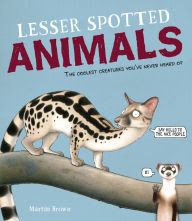Pied Beauty? Lesser Spotted Animals: The Coolest Ceatures You've Never Heard Of by Martin Brown
FED UP WITH THE SAME OLD ANIMALS?
HAD ENOUGH OF HIPPOS? TIRED OF TIGERS?
DO YOU WANT ANIMALS THAT ARE FRESH, NEW, EXCITING?
Up to there with bears? Peeved by penguins? Testy about turtles? Weary of whales? Curmudgeonly about all those ubiquitous cute critters?
Has Martin Brown got a book for you! Brown's brand-new Lesser Spotted Animals
IT'S GOODBYE TO THE GNU! CHEERIO TO THE CHEETAH.
SAY HI TO THE HIROLA AND NICE TO MEET YOU, NUMBAT!
Take the numbat, an exotic compatriot of the well-known wombat (neither of which are bats, by the way), an Aussie marsupial without a pouch, mind you, but a mighty mite of a deep-digging termite eater. Reputed to be cuter than a meerkat, with stripes and a long furry tail, he's still on the endangered list.
Then there's Sammy, the sand cat of the Sahara, who in a small sand storm could easily pass for a orange-stripper house cat. The sand cat is one of those fairly rare psammophillic (sand-loving) creatures, which is a good thing since that's that for his habitat. There is also the dagger-toothed flower bat, of southeast Asia, not a Dracula-wannabe, but a "peaceful pollinator," despite his formidable fangs. Talk about being an unwanted guest--how about the Cuban solenedon, one of the few mammals with a poisonous bite, so venomous that it's not even immune to itself (no hickeys for him!) And how about the gaur, a 2200-pound bison so big that he has had no predators to take him on since ol' Smiley, the saber-toothed tiger, went extinct, likely after breaking his long fangs on an ancestor of the gaur.
And if you think you know all about the lowland and mountain gorilla, what about the zorilla, an even stinkier African cousin of the skunk with white Groucho eyebrows! These and fifteen more quirky critters are profiled in this funny and fact-filled nonfiction book, offered up with wry, self-mocking humor within speech balloons in engaging two-page spreads illustrated by the author. An irreverent but serious nature study, this one comes complete with a glossary which adds more lore, including survival status from "insufficient data" to endangered. Great for middle-reader browsing, supplementary reading, and fine fare for a nonfiction book report, this rave-reviewed book is surely a first purchase for libraries and the zoological zealot out there.
Labels: Animals--Habits and Behavior, Nature Study (Grades 2-6)



0 Comments:
Post a Comment
<< Home